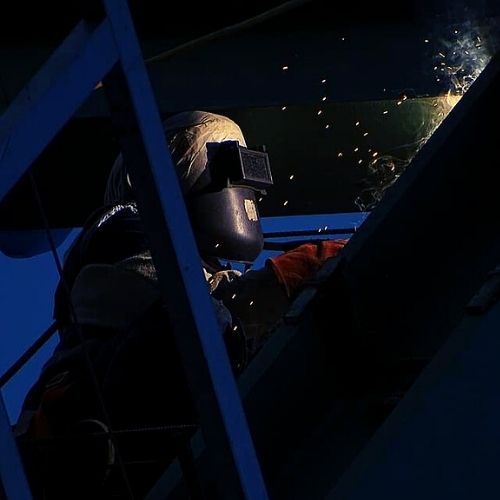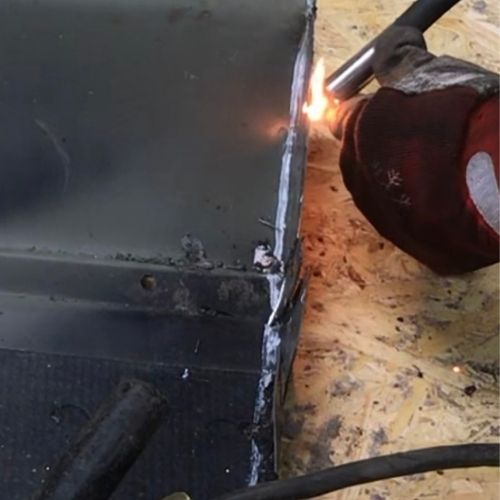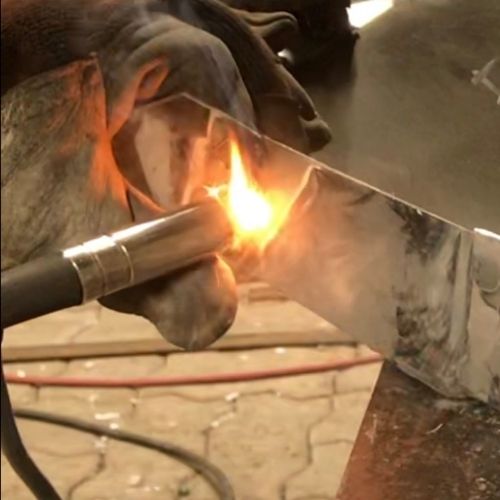
if you have been playing with the idea of welding a beautiful piece of painted metal but you are not sure whether it would be a good idea or not? Well, this article is just the right read for you. I will go over all the basic points you need to know before you go ahead and start your welding project. There can be a lot of factors present in welding which you didn’t think would cause any problems, but they can surprise you. Some of these points can be very important for your health so make sure to read carefully.
Can you weld painted metals? In short, you can, but should you? It is always recommended to properly clean and remove the paint before your weld. Welding on a painted surface can be very harmful to your health and you should be very careful while doing so, make sure to follow all the guidelines before you go ahead.
CAN I WELD PAINTED METAL
Contents
This question is not as simple as it may seem. Yes, you can weld painted metal but the difficulty you will face or the quality of your final weld may depend highly on how you are going about it.
Most of the time you should not directly weld a painted metal, there are some exceptions to this rule you can make but really you shouldn’t. The ideal way to go about it would be to scrape off the paint from the metal and clean it before you decide to go forward with the welding.
But if you have decided to go ahead anyway and weld over the painted metal then there are a few things you should know. For the welding to be possible, the arc will first have to go through the paint by burning it off the surface of the metal. This can lead to a few issues like the arc not being able to strike with the layer of paint over the metal. Another issue can be not enough penetration is being achieved while welding. If you are trying to weld two pieces together, the welding pool will likely not stick on both but drip off before. Lastly, it can also create a lot of poisonous fumes which can have terrible effects on your body. Believe me, these fumes are as nasty as they can be!
Also be ready to see some flames. As we all know, paint burns, and it burns hot.

What a lot of people think is happening during the welding process is that the paint will be burnt off by the time you reach that spot, but in reality, the gases which are being formed by the paint burning can mix in with the weld pool and contaminate the whole weld. This can affect the integrity of the whole weld. Generally welding painted materials works better with thicker stuff. Thicker materials require more heat, thus the paint has more time and area to burn off before you move on with your welding puddle.
You should also be careful while welding a painted surface about the fumes which can generate. A lot of the old painted metals have some traces of lead inside of them which are terrible for your body. Some even might have a zinc layer under the paint which is extremely dangerous. Make sure to wear a good mask and weld in a well-ventilated room.
Make sure to properly clean the surface before going for the weld, it will at least prevent the dust and other particles to be mixed with your weld pool. You will not have a huge problem finding the stick electrode which can penetrate the layer of paint. If you are having trouble striking the arc you can try to chip off the paint near the start (you might as well chip or grind off the entire paint from the area).
CAN I MIG WELD PAINTED METAL?
You should always avoid welding on a painted surface especially with MIG welding as it is not as tolerant of contaminants as stick welding. Although it can be done the end result will not be something you want. It is important to properly clean the surface is using MIG welding.

CAN I SPOT WELD PAINTED METAL?
The state of the metal sheet you are going to be using can greatly affect the weld quality. Contaminants including paint can affect the electrical resistance at the electrode. Any of these contaminants can lead to variable weld quality as the electrical resistance and therefore heat can vary during the weld. It goes without saying that if you need industrial quality welds then you should clean the surface properly and remove the paint layer.
DO YOU HAVE TO REMOVE PAINT BEFORE WELDING?
As I mentioned before, you don’t absolutely need to remove the layer of paint from the metal surface you are working on. But it is highly recommended that you do so. if you chip off or grind off the paint, not only will the final weld look much better but its structural integrity will also improve a lot. I have already talked about what will happen if you decide to weld over the paint but now let’s look at ways of how to remove this layer of paint.
There are a few methods that you can use to remove the paint, one of the most popular ones is to use a wire wheel or flap disc on an angle grinder. This method will also help you to remove a lot of the other impurities on the surface of the metal.
A lot of people also use a grinding disc to do the job. But you should be careful while grinding to not grind away too much base metal as it can compromise its strength. Acetone or nail polish remover is also recommended to clean off any residue of paint left on the surface.
PRECAUTIONS TO TAKE WHILE REMOVING THE PAINT
While there are a number of ways of removing the paint, a lot of them can be dangerous to work with. I have heard stories and witnessed a lot of accidents that have happened during this process. For example, while table grinders or handheld grinders are efficient ways of getting it done, they might throw some loose wires your way once in a while. I have never seen one go through a face shield But they do penetrate your skin.
If you are using a wire wheel, never wear loose clothes while operating it. The machines you are using, are so fast and quick that you will not even know when it grabbed some of your shirts and pulled itself onto you. So be careful!
Although it is obvious that you should go for a good quality angle grinder, even the best of them will cause issues like grabbing or kicking. If you are not paying attention they might even get away from you during the kick. Always remember that you will not stand a chance in front of that thing.
On the other hand, if you are using a grinding disc then please make sure that the disc is in a good shape, a lot of times a damaged grinding disc can come apart during the work and you will have to be extremely lucky to dodge the shrapnel that come your way. A grinding disc is inherently dangerous to use and on top of that if you are using a cracked, old, or damaged device it can make the situation worse.
One other piece of advice that I can give you is to wear a dust mask and remove the paint in a ventilated room as the paint particles along with the dust and metal can harm your lungs in the long run.
SHOULD STEEL BE PAINTED AFTER WELDING?
If you completed your weld then you must be wondering whether you can or should paint over the weld. there are a few things you should keep in mind. Whether a paint job is successful or not depends on a few factors. The first factor is the adherence of the paint with the surface which in this case is the base metal and the weld.
This factor depends upon a few conditions, the biggest reason why paint failure can occur is the lack of cleaning of the base metal and the weld, the roughness of the weld or the metallurgical factors actually do not affect the quality of the paint job as much as people believe. Another factor is the amount of spatter present near the welding.
Paint does not stick itself properly to the spatter and over time some of it might chip away or fall down which gives an opportunity for rust to form underneath the paint.
Therefore, how successful a paint job will depend on whether you took the pre and post preparation related to welding or not. one of the most important pre-treatment you can do is to use a good ant spatter compound. This can greatly reduce the spatter sticking which is formed during welding.
There are two steps which you can take during the post-weld procedures, the first being mechanical cleaning and the second being chemical cleaning. The former involves the use of methods like wire brushing or hand chipping and grit blasting, some of these we have discussed above. A lot of people claim grit or sandblasting and wire brushing to be the most effective methods.
Chemical processes include a chemical bath wash which can help remove slag and other contaminants. Slag being alkaline can cause problems once the paint job has been completed by reacting with the paint and reducing its life.
CAN YOU STICK WELD OVER PAINT
I will repeat again that welding using any technique over paint is not recommended. But when it comes to this particular method, yes, it is possible to overpaint. I would recommend using the E6011 or the 6010 electrode which performs fairly well over rust, dust, and paint and has a deep penetration. Although the presence of paint will not give you the best weld both aesthetically and strength-wise. Out of all the methods out there stick welding can tolerate the greatest number of contaminants on the surface like dust, rust, and paint. You can also try doing multiple passes while welding as the first pass can be used to burn off the paint and excess contaminants.
FREQUENTLY ASKED QUESTIONS
If you were undecided whether you should weld over paint or not, I hope this article helped you in making the decision. Welding anything can be an important process and you want to have all the information related to this before doing the weld. I will try to answer some of the most common and interesting queries related to this topic.
If you have decided to go for the weld but your room is not ventilated properly, one cheap but effective tip is to use a table fan or any small fan which can direct the fumes away from your face. Make sure to not direct the fan at the welding site as it can re-direct the shielding gas.
The combination of powder coating and welding is not recommended by anyone. A lot of issues here are similar to the ones faced in case of welding over paint.
As I have stated before, you have to make sure that the surface is clean from any slag or spatter and also make sure that the anti-spatter coating you applied before the weld is cleaned off properly or compatible with the paint.
CONCLUSION
To sum it all up, always try to remove the layer of paint surrounding your weld area for the optimum weld. Also make sure you are wearing the correct safety equipment if you are welding over paint, wear a mask even when you are removing the paint. Make sure to follow the correct pre- and post-weld clean-up to ensure proper coverage of paint if you decide to do so.
